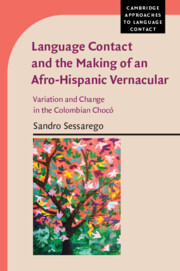 Language Contact and the Making of an Afro-Hispanic Vernacular
Language Contact and the Making of an Afro-Hispanic Vernacular Book contents
- Language Contact and the Making of an Afro-Hispanic Vernacular
- Cambridge Approaches to Language Contact
- Language Contact and the Making of an Afro-Hispanic Vernacular
- Copyright page
- Dedication
- Contents
- Figures
- Tables
- Maps
- Series Editor’s Foreword
- Acknowledgments
- 1 Introduction
- 2 The Place of Chocó Spanish in the Spanish Creole Debate
- 3 A Sketch of Chocó Spanish
- 4 Roots of Some Languages
- 5 Black Slavery in the Pacific Lowlands of Colombia
- 6 Testing the Legal Hypothesis of Creole Genesis on Colonial Chocó
- 7 Final Considerations
- Appendix
- References
- Index
4 - Roots of Some Languages
Published online by Cambridge University Press: 23 August 2019
- Language Contact and the Making of an Afro-Hispanic Vernacular
- Cambridge Approaches to Language Contact
- Language Contact and the Making of an Afro-Hispanic Vernacular
- Copyright page
- Dedication
- Contents
- Figures
- Tables
- Maps
- Series Editor’s Foreword
- Acknowledgments
- 1 Introduction
- 2 The Place of Chocó Spanish in the Spanish Creole Debate
- 3 A Sketch of Chocó Spanish
- 4 Roots of Some Languages
- 5 Black Slavery in the Pacific Lowlands of Colombia
- 6 Testing the Legal Hypothesis of Creole Genesis on Colonial Chocó
- 7 Final Considerations
- Appendix
- References
- Index
Summary
Besides providing considerable ground for hypotheses on creole genesis and evolution, CS and the rest of the AHLAs also have much to offer to linguistic theory, since these varieties are rich in structures and prosodic patterns that would be considered either ungrammatical or pragmatically infelicitous in standard Spanish and that may be used as a powerful testing ground for linguistic hypotheses, which have usually been built on standardized language data (Kayne 1996; Sessarego 2013a, 2014a). In fact, some common features that have repeatedly been reported for the vast majority of these Afro-Hispanic dialects, and that in some cases have been identified as potential indicators of a previous creole stage, represent deviations from standard Spanish that are extremely interesting from a microparametric point of view (Sessarego 2012a, 2013a, 2014a). Some of these recurring grammatical phenomena are: (a) presence of bare nouns in subject position; (b) variable number and gender agreement across the DP; (c) invariant verb forms for person and number; (d) use of non-emphatic, non-contrastive overt subjects; (e) lack of subject-verb inversion in questions; (f) earlier prenuclear peaks – corresponding with higher frequencies of the L+H* pitch accent. Table 4.1 reports features (a–e) with examples taken from some of the Afro-Hispanic dialects presenting them (Sessarego 2015b), while Figure 4.1 exemplifies phenomenon (f) in Afro-Bolivian Spanish (Rao & Sessarego 2016).
- Type
- Chapter
- Information
- Language Contact and the Making of an Afro-Hispanic VernacularVariation and Change in the Colombian Chocó, pp. 103 - 126Publisher: Cambridge University PressPrint publication year: 2019
- 1
- Cited by
